
Monitoring Energy Usage, and Smart Meters
Updated 20 November 2016

|
Monitoring Energy Usage, and Smart Meters Updated 20 November 2016 |
|
HOME PAGES GLOBAL WARMING WHAT YOU CAN DO GREEN ISSUES BACKGROUND THE INITIATIVE |
On this page we describe different ways to
monitor energy usage, how this can help to reduce energy consumption, and
also describe so-called smart meters which are gradually taking over from old-fashioned
electricity and gas meters: Related pages present advice on Saving Energy and miscellaneous Energy-Related Topics. The content of all the articles is summarised on the Energy Advice page. Monitoring Energy Usage of a House Reducing your electricity and gas (or oil) usage saves you money on your bills as well as helping with greenhouse gas emissions. Monitoring is easier to do for electricity and gas than for oil. Some measures, such as switching to more efficient boilers, appliances and gadgets, are obvious. But to track down where the energy is going and which devices are the biggest offenders it’s necessary to measure what you use. We will first discuss whole-house monitors that measure your total electricity, and in some cases your gas, consumption. 
For electricity these are simple, safe, fairly inexpensive devices that are very easy to install. They give immediate information on how much electricity you are using at any given time. They also keep track of total electricity consumption, how much it is costing you, and roughly how much carbon dioxide has been emitted. In most cases the monitor data can also be read into a computer, where you can analyse how your usage is changing over time and store long-term records. When you first install your monitor, you’ll probably wander around the house turning things on and off to see which items are the main culprits, and marvelling at the information at your fingertips. It’s quite addictive! You can learn how much energy many items consume simply by switching them on and off and monitoring what happens to the total consumption. But for appliances that switch on and off intermittently, such as fridges, and for low-power electronic gadgets that use a lot of electricity only because they are on all the time, it is necessary to monitor them individually using a single-device monitor – these are discussed below. It has been claimed that some people save up to 25% on their electricity bills using such devices. In trials carried out in Blewbury several years ago with first-generation whole-house monitors the average saving was about 12%; adding a single-device monitor would probably improve on that. However, the amount you ultimately save will depend upon how conscientious you are in using the monitor information to turn off or reduce the consumption of appliances and gadgets. If you do not need a permanent monitor in your home, it may be sensible to share a whole-house or single-device monitor with neighbours or friends, or to borrow one from Sustainable Blewbury (email us at info@sustainable-blewbury.org.uk). Measuring energy use • Kilowatts (kW) measure power – the rate at which we use energy.
A kilowatt is one thousand watts (W). Power is akin to speed, and energy is akin to distance – as we all know, the faster you go, the more quickly you cover a given distance. Similarly, the more power you use, the faster you consume a given amount of energy. So, if you consume power at 1 kW (using a vacuum cleaner, for example), you will have consumed 1 kWh after one hour. If you only consume power at 10 W, which is 0.01 kW (a low-energy light bulb, for example), it takes 100 hours to consume 1 kWh. The units on your electricity meter measure kWh: one electricity ‘unit’ is one kWh. Electricity tariffs vary, but think of one kWh as costing roughly 15p. Everyone has electrical items that are on all the time, some in standby mode. Every watt that’s used continuously costs well over £1 per year. If various gadgets that are on all the time consume 40 W of power then they will consume about 1 kWh per day, costing about £55 a year. Most houses have a base load of always-on services and gadgets on standby that uses far more than this. Gas is more complicated because the ‘units’ that the meters measure are for a volume of gas. The number of kWh per gas unit depends on whether your meter is metric or not – it will say on the meter if it is metric, and virtually all meters in Blewbury are. Your gas bill will show the conversion factor your supplier is using, which includes a variable calorific value.
Whole-house monitors Whole-house electricity monitors measure the your total electricity consumption using a sensor clamped around the live input cable to your mains electricity meter. In most cases installing the sensor is easy and doesn’t require an electrician. The sensor transmits information wirelessly to a display – usually portable, so it can be viewed in a convenient place. It shows your immediate consumption in kilowatts, and your total energy usage in kilowatt-hours or pounds added up over hours, days or months. Many models can also be connected into a computer, where tables and graphs that analyse your usage over time can be displayed. A large number of households in Blewbury either have one of these monitors or have borrowed one, and found them very effective. A few of these monitors incorrectly claim to be ‘smart meters’. We discuss smart meters below – the display provided with a smart meter should make a separate whole-house meter unnecessary. Most whole-house electricity monitors are priced between £35 and £50, with a few that offer better facilities or more ‘style’ costing more. Some models have add-on options, such as gas monitoring. You can also find simpler, older models for less than £30. Look online to find the best prices. Energy suppliers will sometimes give you a monitor for free if you are on certain tariffs – call yours and ask. 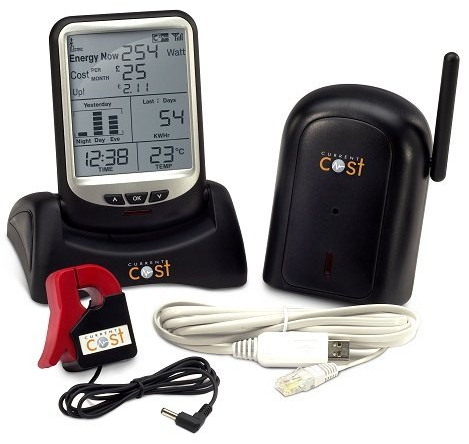 
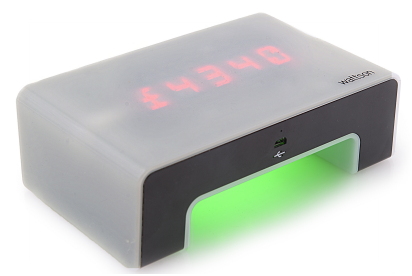
Some other whole-house monitors:
The in-home monitoring of gas is possible with sensors connected to a gas meter, provided it has a compatible digital readout. A fairly standard whole-house electricity monitor that also offers a transmitter to allow easy monitoring of gas consumption is the Saveometer (www.saveometer.com). Comments The sensors of whole-house monitors simply clip on to a live cable carrying one phase of electricity supply, and detect the current flowing in the cable. (This is normally a red cable about 1 cm in diameter.) In most cases installation is quick and easy. But if there is nowhere that you can access such a cable it will be necessary to get a qualified electrician to install the sensor. If you have solar photovoltaic panels for electricity generation, it is important to realise that the sensor only measures that current is flowing – it cannot tell the difference between electricity being taken from the grid and generated electricity being sent out to the grid. This means that the monitor’s electricity consumption readings are misleading during daylight hours and only valid at night, when solar panels are not operating. Very few monitors have facilities for correct handling and monitoring of total electricity inputs and outputs for buildings with solar panels. These monitors assume a nominal voltage of 240 volts. Since mains voltage can vary, e.g. it might be 230 or 250 volts, the energy reading might be inaccurate. Finally, the phase of the voltage may not match that of the electrical current. This can happen with certain kinds of loads, for example some fluorescent light fittings, and in that case the energy being consumed is overestimated. The monitors described above are useful for determining when excessive consumption of electricity and gas is taking place, and to some extent which devices are using electrical energy. Although the monitors themselves also provide limited information on total usage over pre-defined periods, for the monitors with computer connections you can do much more extensive monitoring with the software provided. The electricity consumption per day when the house is unoccupied shows the total base load, which is likely to be made up by devices such as fridges, phones, clocks, central heating controls, house alarms, and devices on standby. This may include devices that you did not realise were still taking energy, such as immersion heaters or pumps. The difference between summer and winter consumption will be striking for the fuel used for heating. Even if electricity is not used for heating there will be significantly higher consumption in winter because of the extra lighting used. The difference can give an indication of the savings that might be made by more extensive use of low-energy lighting. You may also notice the extra consumption when guests are staying, or gain an understanding on how the heating bill changes with outside temperature. While it is possible to save and analyse meter readings yourself, there are also software packages offering to collect your readings and analyse them for you. For example, Current Cost (www.currentcost.com) and Efergy (www.efergy.com) offer such packages for use with their monitors. Single-Device Electricity Measurement Once you’ve monitored your whole house you will probably want to look in more detail to find out where the electricity is going. A single-device monitor provides an easy and inexpensive way to do this. You can buy a simple plug-in monitor for about £10–15. Some whole-house monitors mentioned above can also do this (e.g. Current Cost models), but if you have to buy an optional sensor it may be cheaper, easier and more accurate to choose a separate single-device monitor. The monitor goes between an appliance or gadget and the wall socket, and provides a 13 amp socket to feed the device being measured. (An extension lead can help if the monitor is hard to read right at the socket.) All single-device monitors display the instantaneous power being drawn, and work reasonably well in the range from tens of watts up to kilowatts. It is very useful to have a monitor that can measure right down to 1 watt or less – some of these monitors aren’t sensitive enough to measure such low consumption, which means they can’t measure devices when they are in standby mode or switched off. (Sadly, ‘off’ does not always mean fully off – see our article about devices on standby.) A very desirable extra feature is the ability to add up the total amount of energy used over a period of time. Most of these monitors do that, but models without back-up batteries lose the information when the monitor is unplugged or the socket is turned off. When we tested single-device monitors we found that although there are many models available, quite a few of them were similar inside – not surprising since a lot of these are sold under the brand name of the retailer. 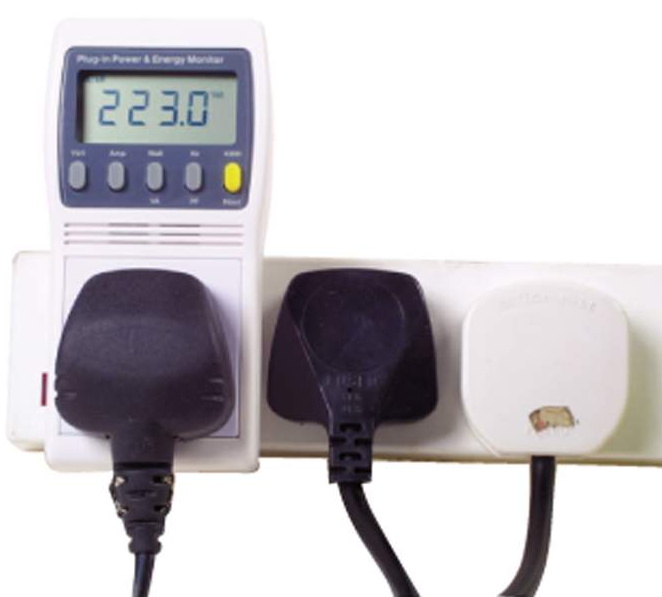
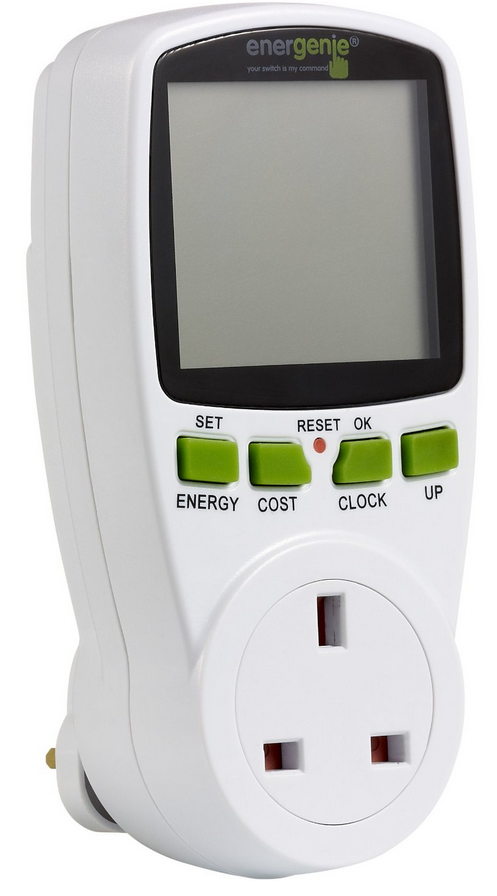
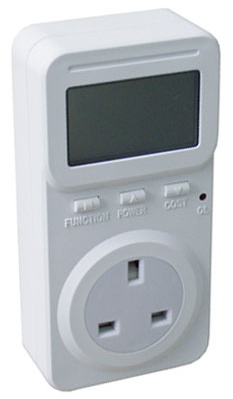
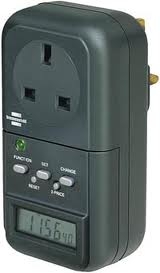
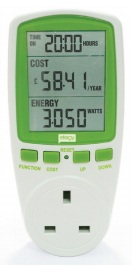
Old-fashioned electricity and gas meters are gradually being replaced by smart meters. Smart meters send readings directly to the energy provider, can handle variable tariffs, and provide accurate and detailed monitoring of electricity and gas consumption on an in-home display. Some in-home displays can also be used to control appliances and heating systems. Here we describe these devices and discuss their benefits and problems. For more information on smart meter basics there is a Government guide. The Blewbury Energy Initiative encourages the universal use of smart meters in homes as soon as possible, in order to reduce energy bills and CO2 output. Delays in agreeing a standard but flexible specification, combined with communications difficulties, have led to the rollout starting at the end of 2016, with completion due by the end of 2020. Initially, smart meters will cover electricity and gas, but we hope water will also be included as soon as possible. You will not be expected to pay for a smart meter, but the cost will be recovered via slightly higher energy bills for all consumers. Energy supply companies are currently being required to install smart meters and take all reasonable steps to reach everyone. However, although you are not yet legally required to have one, we encourage you to do so as soon as the problems identified below have been resolved. The photos show a smart gas meter, a touch-screen in-home display showing a menu of standard functions, and a display in use. 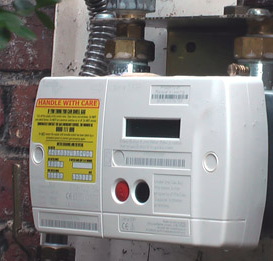
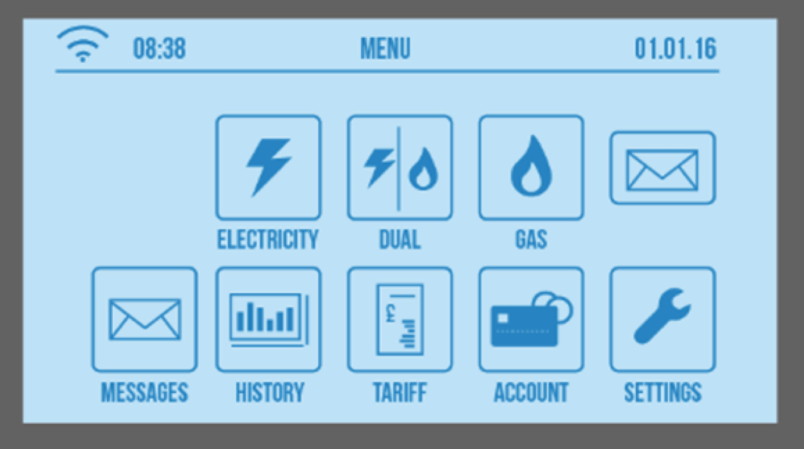
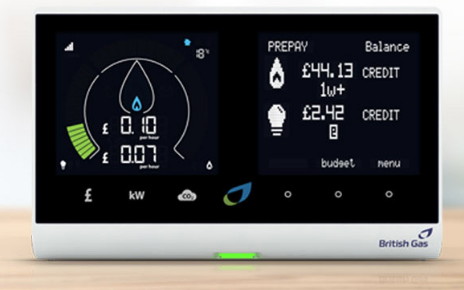
Benefits and problems In theory, smart metering is always ‘live’, so the grid network can monitor demand and optimise supply, thus making best use of low-carbon energy sources as they become available in real time. Energy tariffs can be more flexible, based on demand at different times and on different days. However, because it is not yet mandatory for consumers to have smart meters the information on electricity demand will not be very accurate or complete. There is also doubt about the availability of real-time data for the network operator (the company that is responsible for the pipes and wires supplying your home), as opposed to the energy suppliers (the companies that you buy your electricity and gas from). Most of the smart meters being installed today use mobile phone-type wide-area network signals to send meter readings to your energy supplier(s), and local wireless to send information to the in-home display. However, and perhaps astonishingly, some smart meters have been installed in areas without adequate wide-area network coverage. One of the problems is that the smart meters are being installed by the many energy supply companies at random. It would have been far better to have installation done area by area by the gas and electricity network operators, as they are the people who require real-time data for optimising the local smart grid (see below). Consumers benefit by having billing based on real meter readings rather than estimated readings that are often very inaccurate. The in-home display/control units can help to optimise use of gas and electricity (and hopefully water in the future). The first generation of smart meters (so-called SMETS1), now superseded but still being installed in some homes, do not always allow switching of energy suppliers. Some households have had to revert to a ‘dumb’ meter mode when they switched suppliers. The second generation of smart meters (SMETS2) can handle switching of suppliers. However, at the time of writing some suppliers are still installing first-generation meters. There is confusion about responsibility for the smart meter setup if a consumer of both electricity and gas with a combined electricity and gas smart meter uses different companies to supply them, or switches suppliers separately. Many of the future benefits of smart meters require that all users should have them. However, so far installation has been voluntary and users can opt out. It would be far better if installation was universal, and done on an area by area basis. For homes with microgeneration, such as solar photovoltaic panels, a suitable smart meter should be able to show how much electricity has been generated, and how much of it has been used locally or exported to the grid. However, this facility is not available on all smart meter systems. Homes in the UK that have had smart meters installed on a trial basis are already showing savings on their energy bills, and a reduction in CO2 emissions. British industry has widely adopted smart metering on a large scale with even greater energy efficiency. Other European domestic consumers have been able to enjoy the benefits of smart meters for some years owing to simpler organisation of their energy industries, with regulated geographic monopoly suppliers. Variable tariffs Smart meters can handle electricity and gas tariffs that vary according to time and day of use, a much more flexible version of older schemes like Economy 7 which provide cheaper electricity at night when demand is lower. With a smart meter there is no need to connect some appliances to a separate ‘low tariff’ meter, and the time of day for cheaper tariffs need not be rigidly fixed. This has the benefit of allowing consumers to run appliances like washing machines and dishwashers, as well as recharge electric or plug-in hybrid cars, when electricity is cheaper. This can also help to spread out the peak load on the grid. However, unless the in-home display provided gives a clear breakdown of usage and tariffs, a possible problem is that it might be difficult to check bills and consumers may be confused. In principle the tariff can also vary dynamically during the day according to demand, and interact with some appliances that could be turned off for short times (see next section). This would be beneficial in handling intermittent demand as well as intermittent supply from renewable energy sources such as wind and solar. However, unless this can be done in a clear and relatively simple way it could cause still more confusion in checking energy bills. Smart appliances Some electrical devices can be turned off for short periods without significantly affecting how well they function. The most common example is a fridge or freezer, which is insulated well enough to allow being turned off for short periods (provided the door is not opened). Another example is heat pumps used for central heating. In the future, as more electric and plug-in hybrid cars are used, recharging their batteries would mainly be done overnight and could also be interrupted if necessary. The smart meters being installed now can’t control appliances. However, an obvious extension of smart metering is to have devices like the ones mentioned above communicate with a smart meter, so that if overall electricity demand rises suddenly they can be turned off for a short time. Suppliers may offer cheaper deals or special appliances to customers who are willing to allow them to be switched off when there is high energy demand on the grid. To achieve the full benefits of smart appliances everyone must have a smart meter, but this is not yet mandatory. Although smart appliances sound good in principle, there are basic issues that must be addressed concerning who is in control. In some cases there may be a good reason not to allow the electricity supplier to turn the device off – for example, a car being recharged may be needed as soon as possible, or a fridge or freezer may have to be opened. There are concerns that the proposed rules could be more ‘top down’ than ‘bottom up’, so they favour energy suppliers more than consumers. This would have to be resolved. Energy storage and smart grids Another big change for the future is to install various means of storing large amounts of electrical energy. These range from pumped water reservoirs (as already exist at Dinorwig in Wales and Cruachan in Scotland) and tidal basins to large-scale battery packs, both domestic and larger. That would include batteries for storing the electrical output of solar panels during the day for use at night, and possibly for storing up wind energy for periods of little wind. A big increase in storage facilities would allow full use of peak output from various renewable energy sources to help compensate for intermittent troughs in output. Increased availability of energy storage, smart appliances and more interconnections with other regions in northern Europe are all part of moving to a so-called smart grids environment, which can cope with changes in output (notably from renewable energy sources) and demand much more flexibly than at present. Warnings about smart meter installation If you are approached by any energy supplier to install a smart meter we advise you not agree until you are satisfied that the smart meter:
Other concerns regarding smart meters Cost – The cost of installing smart meters will come out of energy bills, and will add to the already rising cost of energy to all consumers. Remote disconnection – Smart meters make it technically possible to disconnect consumers from their electricity or gas supply remotely, without anyone visiting the home. Rules for making sure that this only happens when fully justified have been introduced, but how well they will work remains to be seen. Privacy – Smart meter data might be used to invade your personal privacy. For example, your energy data could indicate your pattern of living and what you are doing in your own home. Suppliers will not be allowed to collect real-time data without your agreement. However, the local network operator will need real-time electricity data for smart grid optimisation and local community schemes. It is not yet clear who else will have access to this data and for what purposes. For example, will local councils or security services have access to information? Security – Smart meters might be hacked, to steal or manipulate their data. Suppliers are responsible for ensuring that smart meters installed now are secure. However, security standards have not yet been finalised, so we cannot be sure that smart meters being installed now will meet the future standards. Safety
Our view Because of the confusion and uncertainties about the smart meter rollout programme, the Blewbury Energy Initiative has written to various bodies recommending that the rollout is temporarily halted to review the overall strategy. We have stressed that the provision of smart meters for all consumers should be carried out by the network operators on an area-by-area basis rather than by the energy suppliers. This would provide uniformity in a neighbourhood, facilitating smart grid optimisation for renewable energy, reduced costs, and could ensure regular safety inspections. |
 |
If you have any comments or queries about this website please contact the
webmaster. |
© Blewbury Energy Initiative 2016 |